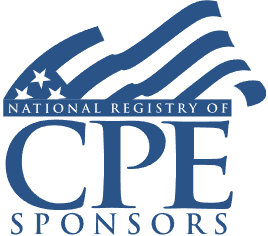Foreign Tax Credits on Schedules K-2 and K-3: Clarifying and Simplifying Reporting Guidelines for Parts I-III

Course Details
- smart_display Format
On-Demand
- signal_cellular_alt Difficulty Level
Intermediate
- work Practice Area
Tax Preparer
- event Date
Tuesday, January 14, 2025
- schedule Time
1:00 p.m. ET./10:00 a.m. PT
- timer Program Length
110 minutes
-
BARBRI is a NASBA CPE sponsor and this 110-minute webinar is accredited for 2.0 CPE credits.
-
BARBRI is an IRS-approved continuing education provider offering certified courses for Enrolled Agents (EA) and Tax Return Preparers (RTRP).
This webinar will focus on entering and simplifying the reporting of foreign tax credits on Schedules K-2 and K-3. Our panel of international tax reporting experts will walk you through Parts 1, II, and III of these schedules and provide tips and examples of common and complex foreign tax credit reporting situations.
Faculty

Mr. Samtoy’s practice specializes in international tax compliance and consulting services, with a focus on individuals, closely-held businesses, and hedge funds. He has particular expertise in structuring and reporting foreign manufacturing arrangements and foreign holding companies, and is experienced in foreign asset disclosure requirements, as well as foreign trust and estate reporting.

Mr. Neumeyer focuses his practice on international tax issues. In particular, he helps lead CLA’s delinquent international filing practice. Mr. Neumeyer works with clients who have missed international informational reporting requirements and helps mitigate penalty risk by submitting delinquent returns through IRS voluntary disclosure programs. He also works extensively with multinational businesses by helping navigate their international compliance obligations.

Mr. Wilhoite brings a diverse background of experience in both domestic and international tax matters to his practice at CLA. Drawing on several years of experience working in the tax advisory group of a Fortune Global 500 company, Mr. Wilhoite offers valuable insights that help multinational enterprises operating in the US identify and develop tax-efficient pricing and structuring opportunities. As a member of CLA’s delinquent international filing practice, he helps clients mitigate penalty exposure by leveraging IRS voluntary disclosure programs. His expertise also extends to IRS controversy and penalty abatement, ensuring comprehensive support for his clients' tax needs.
Description
Schedules K-2 and K-3 are still relatively new. These schedules are also constantly updated, making completing these efficiently and correctly a problem for international tax practitioners. Part I, Partnership's Other Current Year International Information, provides 13 tax boxes to notify recipients of additional tax reporting responsibilities. The parts applicable to foreign tax credit determinations include boxes 1, 4, and 5: gain on personal property sales, foreign tax translation, and high-taxed income. If any box is marked, additional attachments are required, providing the relevant tax reporting details.
Part II, Foreign Tax Credit Limitation, is divided into two sections: gross income and deductions. Since different rules apply for sourcing various types of income, each type is reported separately in Section 1. Complicating the reporting is that sales of personal property must be sourced based on a partner's residence. Country code XX is provided as a choice when the individual partner is required to make this determination.
Part III, Other Information for Preparation of Form 1116 or 1118 provides the information preparers need to allocate and apportion specific expenses. Similar to the complexities of reporting gross income, each expense item, interest and R&E, for example, is subject to different guidelines and must be reported separately.
The reporting requirements for foreign tax credits on Schedules K-2 and K-3 are complicated. Tax practitioners must understand these guidelines so that multinational taxpayers fully benefit from valuable foreign credits.
Listen as our panel of international tax advisers reviews and explains the intricacies of preparing Schedules K-2 and K-3 for global tax practitioners.
Outline
- Reporting foreign tax credits on Schedules K-2 and K-3: introduction
- Part I - Partner's Share of Partnership's Other Current Year International Information
- Part II - Foreign Tax Credit Limitation
- Part III - Other Information for Preparation of Form 1116 or 1118
- Domestic entity filing exception
- Examples
- Other considerations
Benefits
This webinar will cover these and other critical issues:
- Sourcing income by category for Part I, Schedules K-2 and K-3
- Allocating and apportioning expenses for foreign tax credits
- Recommendations for simplifying the completion of Schedules K-2 and K-3
- When a partner in a partnership eligible for the domestic filing exception should request Schedule K-3
- Examples of completing Schedules K-2 and K-3 and the related Form 1116
NASBA Details
Learning Objectives
After completing this course, you will be able to:
- Identify categories of gross income reported under Part II of Schedules K-2 and K-3
- Determine when a partner should request Schedule K-3 from a partnership that meets the domestic entity filing exception
- Ascertain recommendations for simplifying preparation of Schedules K-2 and K-3 for FTCs
- Decide when attachments to Schedule K-3 are required
- Field of Study: Taxes
- Level of Knowledge: Intermediate
- Advance Preparation: None
- Teaching Method: Seminar/Lecture
- Delivery Method: Group-Internet (via computer)
- Attendance Monitoring Method: Attendance is monitored electronically via a participant's PIN and through a series of attendance verification prompts displayed throughout the program
- Prerequisite: Three years+ business or public firm experience preparing complex tax forms and schedules, supervising other preparers or accountants. Specific knowledge and understanding of international taxation including residency determination, foreign entity classifications, application of treaty benefits, as well as GILTI, Subpart F, and the related Section 250 deductions.

Strafford Publications, Inc. is registered with the National Association of State Boards of Accountancy (NASBA) as a sponsor of continuing professional education on the National Registry of CPE Sponsors. State boards of Accountancy have final authority on the acceptance of individual courses for CPE Credits. Complaints regarding registered sponsons may be submitted to NASBA through its website: www.nasbaregistry.org.

Strafford is an IRS-approved continuing education provider offering certified courses for Enrolled Agents (EA) and Tax Return Preparers (RTRP).
Related Courses

Medicaid Asset Protection Trusts: Technical Overview and Tax Considerations
Available On-Demand

Family Partnerships: Navigating the Discounting Rules for Family-Controlled Entities
Thursday, March 6, 2025
1:00 p.m. ET./10:00 a.m. PT

Form 1041 Schedule D: Reporting Capital Gains for Trusts and Estates
Available On-Demand
Recommended Resources
How CPE Can Bridge the Gap Between What You Know and What You Need to Know
- Career Advancement